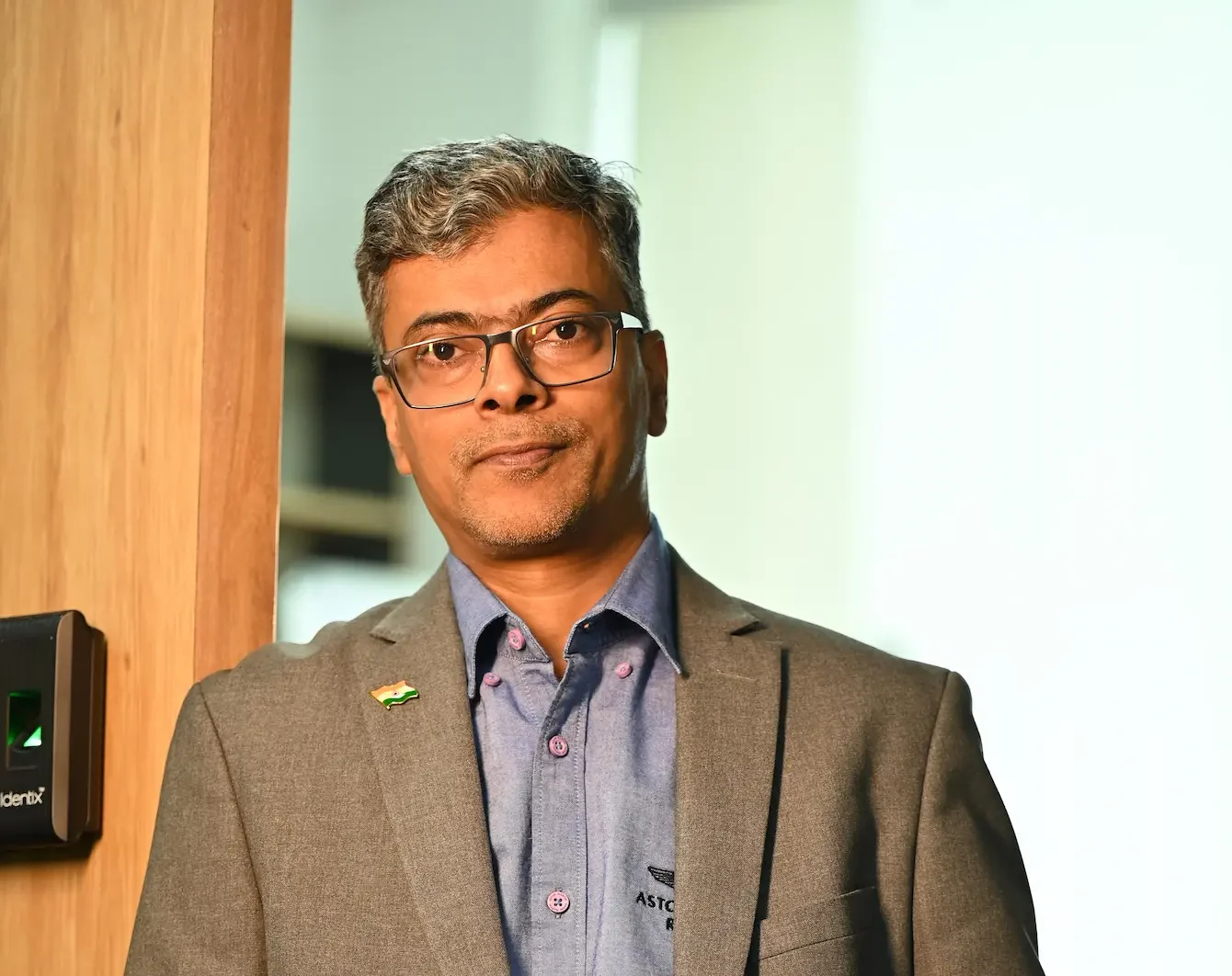In an era where digital transformation has become the cornerstone of business evolution, few leaders have navigated its complexities with the depth of understanding and strategic vision that Abhijit Pal brings to the table. As an Executive Director and Board Member at Alphaxine Solutions Pvt Ltd, Pal has pioneered an approach to technology consulting that transcends conventional metrics—one that places business objectives, cultural adaptation, and measurable outcomes at the heart of digital strategy. This month’s cover story explores how his 25-year journey in technology consulting shaped a visionary who is redefining digital transformation across India, and examines the philosophy behind his success in driving technological change with purpose.
A Digital Vision Forged Through Early Specialization
Abhijit Pal’s technological journey began during a transformative period in India’s history—the late 1990s IT boom that saw the sector experiencing phenomenal 40% annual growth. While many engineers were naturally drawn to this burgeoning field, Pal distinguished himself through self-driven programming expertise that extended well beyond academic requirements.
“I was particularly fascinated by studying industry trends and understanding Indian IT’s global impact,” Pal reflects. “Even as a student, I was drawn to how domestic firms were delivering world-class software solutions on an international stage.”
This early interest wasn’t merely academic. It laid the groundwork for a career that would begin at a top global accounting advisory firm, where Pal played an integral role in building its Indian Technology Consulting practice. These formative experiences cemented his belief in making lasting contributions to the industry, driven by a powerful combination of hands-on software engineering skills, technological foresight, and strategic participation in India’s emergence as a global IT powerhouse.
For Pal, technology was never merely about code or systems. From his earliest professional endeavors, he viewed digital transformation as a vehicle for business evolution, cultural change, and societal impact. This philosophy eventually crystallized in his role at Alphaxine Solutions, where as an Executive Director, he has pioneered approaches to digital transformation that honor business objectives while driving sustainable technological advancement.
The Dual Strategy: Stability and Innovation
At the core of Pal’s current vision lies a pragmatic yet ambitious dual approach that balances immediate business needs with long-term innovation goals.
“After over 25 years of working with diverse clients and addressing complex business challenges, I’m channelling that experience into growing a technology startup focused on solving real customer problems through cost-effective and impactful solutions,” Pal explains.
His strategy operates along two complementary tracks:
- Operational Foundation: Establishing stable business operations by offering dependable, mainstream technology services that ensure consistent cash flow—the bedrock of sustainable growth.
- Innovative Solutions: Dedicating significant resources to building digital products and solutions, particularly in healthcare and education domains—sectors that Pal identifies as having urgent needs for digital transformation to drive inclusive and sustainable societal impact.
This balanced approach represents a departure from conventional startup models that often chase emerging technologies without establishing financial stability. Pal’s methodology ensures that innovation is funded through reliable service revenue—creating a self-sustaining ecosystem that can weather market fluctuations while pursuing meaningful technological advancement.
The Science of Digital Transformation
For Pal, successful digital transformation isn’t driven by technology hype but by a methodical understanding of organizational needs and structured implementation approaches. His methodology involves several interconnected elements, each informed by his perspective on business-led digital transformation:
- Digital Maturity Assessment (DMA): Before implementing any solution, Pal’s team conducts a comprehensive evaluation of the organization’s current state across multiple dimensions—technology, data, leadership alignment, culture, strategy, and user adoption—identifying gaps relative to desired maturity levels.
- Structured Transformation Roadmap: Insights from the DMA define a targeted strategy and a practical implementation roadmap, ensuring resources are allocated to areas of greatest impact.
- Organizational Change Management (OCM): Recognizing that technology adoption is fundamentally a human challenge, Pal positions OCM as a central pillar of transformation methodology, supporting the journey through awareness-building initiatives, structured training programs, and tailored incentive mechanisms.
- Leadership Alignment and Culture Development: Through workshops and collaborative sessions, Pal actively plays a role in strengthening the leadership vision and in transforming the same into reality and creating an innovation culture needed to sustain transformation momentum.
This integrated approach has yielded tangible results across diverse sectors, from cement manufacturing to global insurance. “What I’m particularly proud of was our ability to return to the client with clearly documented, tangible outcomes such as improved process efficiency and measurable cost savings,” Pal notes. These results not only validated his approach but also led to multiple accolades, reinforcing the value delivered through these engagements.
Crossing Geographic and Cultural Boundaries
Having led both Indian and international transformation projects, Pal has developed unique insights into how digital strategies must be tailored to different markets while maintaining core principles.
“The core objectives of business and digital transformation initiatives are largely consistent across geographies,” Pal observes. “However, key differences exist in the approach to strategy formulation, execution, and value realization.”
His cross-cultural observations reveal important distinctions:
- In Indian contexts, transformation projects often demand deeper subject matter expertise from consultants, and require consultants to focus more on guided well-defined scope and structured implementation roadmaps
- International engagements typically emphasize a broader knowledge base, diverse technology options, and stronger focus on measurable business outcomes, with clients seeking trusted advisory support throughout their transformation journey.
These nuanced differences inform Pal’s approach to project design and delivery, ensuring cultural relevance while maintaining consistent quality standards. His ability to navigate these complexities has made him particularly effective at bridging western methodologies with Indian implementation realities—a valuable skill in today’s globalized business environment.
Case Study: Digital Transformation in Manufacturing
The effectiveness of Pal’s methodology is clearly demonstrated in the transformation of a leading cement manufacturing company in India. Facing increasing competition and pressure to modernize operations, the company partnered with Pal to implement a comprehensive digital transformation initiative.
Before Transformation:
- Manual processes across multiple business functions
- Limited data visibility and analytics capabilities
- Siloed departments with minimal cross-functional collaboration
- Higher operational costs due to inefficiencies
After Implementation:
- Streamlined operations through targeted automation
- Enhanced decision-making through integrated data analytics
- Improved cross-departmental collaboration and information sharing
- Significant measurable cost savings and efficiency improvements
This transformation showcases the tangible business impact of Pal’s structured approach, resulting in improvements that exceeded industry average performance metrics and delivered documented ROI that justified the transformation investment.
The AI Revolution: Beyond the Hype
When discussing the technologies that will create the biggest impact across India in the next five years, Pal’s perspective is both informed and measured.
“According to a recent Gartner report, 74% of CEOs believe that AI will be the most transformative technology for their industries—a sentiment I strongly agree with,” he states. “Over the past few years, what began as hype around AI is now translating into tangible impact across sectors.”
Rather than focusing solely on AI’s potential, Pal emphasizes the foundational elements required for its successful implementation:
- Data Strategy and Architecture: Since data is the foundation of any AI initiative, having a well-defined data strategy and architecture is essential as organizations scale their AI capabilities.
- Governance Frameworks: Critical work remains around data privacy, security, and the development of robust AI governance frameworks to ensure ethical and responsible implementation.
- Complementary Technologies: Accelerated adoption of Extended Reality (XR), drones, 3D printing, and hybrid computing models will work alongside AI to drive the next wave of digital transformation.
This balanced view of emerging technologies exemplifies Pal’s approach to innovation—enthusiastic about possibilities while pragmatic about implementation requirements. His focus on responsible AI adoption rather than uncritical enthusiasm has made him a trusted voice in guiding organizations through technological change.
The Art of Leadership in a Digital-First World
Through his extensive experience leading transformation initiatives, Pal has developed a nuanced understanding of leadership principles that drive technological success.
“I believe leadership is more of an art than a science,” Pal reflects. “While leadership books and lessons can certainly provide guidance and frameworks, the core of effective leadership is often inherent—shaped by an individual’s values, instincts, and emotional intelligence.”
From his perspective, two qualities stand as essential for aspiring technology leaders:
- Structured Thought Process: The ability to think clearly and strategically, approaching complex problems with analytical rigor and systematic evaluation of options.
- Strong Communication Skills: The capacity to articulate ideas with clarity and confidence, enabling leaders to inspire teams, align stakeholders, and drive meaningful outcomes across any domain.
This leadership philosophy has informed Pal’s approach to team development at Alphaxine Solutions, creating a culture that values both analytical thinking and effective communication—key competencies for navigating the complexities of digital transformation.
Bridging Business and Technology: The Trusted Advisor Approach
One of Pal’s most distinctive contributions to the field of technology consulting is his approach to aligning business goals with technological solutions, particularly for organizations still maturing digitally.
“My approach has always been placing business objectives at the forefront of any technology initiative,” he explains. This business-first mindset is operationalized through several key practices:
- Design Thinking Workshops: Collaborative sessions that identify core business challenges before considering technological solutions.
- Business and Technology Canvas Models: Structured frameworks that ensure alignment between strategic objectives and technical implementation.
- Enterprise Architecture Frameworks: Established methodologies that guide technology decisions within the context of broader organizational goals.
- Agile Delivery Models: Iterative development approaches that allow for continuous client feedback and adaptation to evolving business needs.
This methodical approach to technology consulting represents a departure from solution-first models that often lead to misaligned investments and implementation failures. By positioning himself as a trusted advisor who “puts himself in the client’s shoes,” Pal has established a reputation for delivering practical, cost-effective solutions that address genuine business pain points rather than implementing technology for its own sake.
Transforming Healthcare Through Technology
Among the various sectors where Pal has made an impact, his work in health-tech stands out for its potential to create meaningful societal change. His vision for healthcare transformation extends beyond efficiency improvements to fundamental shifts in how care is delivered and accessed.
“India is at a pivotal point in advancing value-based healthcare (VBHC) for its communities,” Pal observes. “While several government initiatives are underway, I believe individual contributions—particularly from the healthcare and technology sectors—are equally critical in driving this transformation.”
His focus areas in healthcare innovation include:
- Senior Care Solutions: Digital platforms that enhance quality of life and care coordination for aging populations.
- Home Healthcare Technology: Systems that extend care delivery beyond traditional clinical settings, improving access and reducing costs.
- AI-Based Clinical Diagnostics: Advanced algorithms that improve diagnostic accuracy and speed, particularly in resource-constrained environments.
- Telemedicine Infrastructure: Connectivity solutions that bridge geographic barriers to care, especially critical in India’s diverse geographical landscape.
- Mental Wellness Platforms: Digital tools that address the growing need for accessible mental health support.
By leveraging AI and digital platforms in these domains, Pal aims to shift healthcare focus from curative to preventive approaches—a transformation that could dramatically improve health outcomes while reducing system costs. This vision exemplifies his broader philosophy of using technology as a catalyst for societal change, extending beyond business metrics to meaningful human impact.
Cultivating the Next Generation of Technology Leaders
Beyond his direct business impact, Pal has made significant contributions to developing India’s technology talent ecosystem through active involvement in mentoring startups and career coaching. His observations reveal important insights about the challenges facing India’s emerging tech leaders.
“The availability of top-tier talent for startups tends to vary significantly across different regions of the country,” Pal notes. “In some areas, a generally risk-averse mindset among technocrats or a preference for beginning their careers with established brands can limit the talent pool for emerging ventures.”
To address these challenges, Pal has engaged in multiple industry-academia collaboration initiatives, conducting targeted workshops and sessions with students and early-career professionals. These efforts focus on developing not only technical and business knowledge but also the right mindset and clarity of purpose to align with long-term career goals.
His message to young professionals reflects his own journey of continuous learning: “Keep your learning mindset active and consistently engage with technology initiatives. It’s crucial to be hands-on and proactive in your learning journey, as real growth comes from practical experience.”
This commitment to talent development represents an investment in India’s digital future, ensuring that the next generation of technology leaders is prepared to navigate evolving challenges with both technical competence and strategic vision.
The Future of India’s Digital Economy
Looking ahead to 2030, Pal sees tremendous potential for India’s position in the global digital economy, informed by both industry projections and his own observations of the country’s technological trajectory.
“According to a report by the Ministry of Electronics and Information Technology (MeitY), the digital economy is projected to contribute 20% of India’s GDP by 2029-30,” he states. “I believe this transformation will have a profound impact on the ‘Future of Work’ in India.”
With India’s immense talent pool, Pal believes the country is positioned to be a global leader in the digital era—not just as a service provider but as an innovation hub. However, realizing this potential requires addressing two critical imperatives:
- Helping business owners achieve digital maturity: Ensuring that enterprises across sectors and scale can effectively leverage digital capabilities to enhance competitiveness and growth.
- Preparing the next generation to be digitally ready: Developing talent with the skills, mindset, and adaptability needed to thrive in an increasingly automated and AI-driven work environment.
Pal sees leaders like himself playing a pivotal role in this transformation—serving as bridges between traditional business models and digital futures, between academic knowledge and practical implementation, and between global best practices and uniquely Indian solutions.
The Legacy of a Digital Alchemist
As Executive Director and Board Member at Alphaxine Solutions, Abhijit Pal has created a legacy that extends beyond traditional business metrics. His vision of technology as a force for business transformation and societal good represents a strategic reimagining of digital purpose for the 21st century.
Through his work empowering organizations, mentoring talent, and advancing a more business-aligned model of digital transformation, Pal embodies a new paradigm of technology leadership. He balances strategic vision with practical implementation, innovation with fiscal responsibility, and technological advancement with human-centered design.
In an industry often characterized by hype cycles and short-term thinking, Pal’s approach offers a compelling alternative: technology as a bridge between business objectives and human needs, a catalyst for organizational evolution, and a vehicle for positive societal impact. His story reminds us that true success isn’t measured in technological sophistication alone, but in problems solved and value created.
As India continues to navigate its digital transformation journey, leaders would do well to consider Pal’s central insight: lasting technological success comes not from following trends, but from understanding business problems deeply and applying the right solutions—whether simple or sophisticated—to address them effectively.
Taking Action: Embracing Structured Digital Transformation
In today’s hypercompetitive business environment, structured digital transformation has become an imperative across sectors. Organizations without a methodical approach to digital evolution face significant risks:
- Higher failure rates when implementing new technologies
- Greater difficulty adapting to changing market conditions
- Missed opportunities to improve operational efficiency and reducing cost
- Unpreparedness for the increasingly digital expectations of customers and employees
The leaders of tomorrow are those who act today—who recognize digital transformation not as a one-time technology upgrade but as a continuous journey of business evolution enabled by thoughtful technology adoption.
“My core belief is that most business challenges can be addressed by first gaining a thorough understanding of the problem,” Pal emphasizes. “Once that clarity is achieved, the solution often lies in applying simple yet innovative approaches—rather than defaulting to complex, high-hype technologies.”
The time for structured digital transformation is now.







